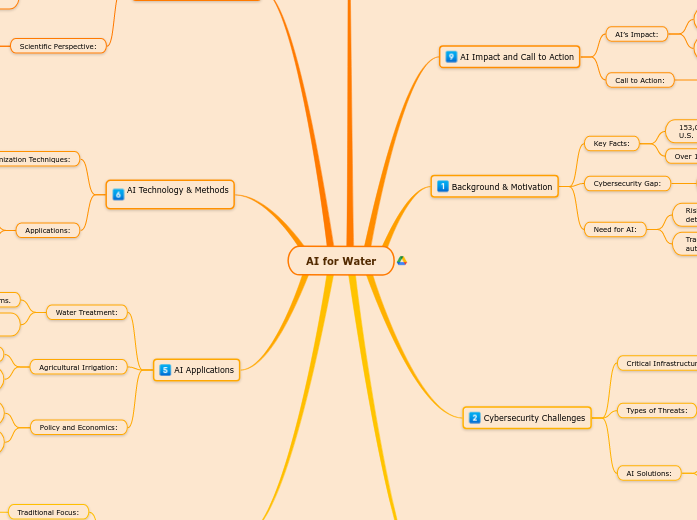AI for Water
Challenges in AI Deployment
Barriers:
Black box nature of AI models.
Concerns about data privacy and security.
Resistance from operators reliant on traditional methods.
Solutions:
Develop explainable AI models.
Train operators on AI tools.
Address privacy concerns with stronger frameworks.
AI Impact and Call to Action
AI’s Impact:
Essential for enhancing water security and sustainability.
Tackles both traditional (availability) and modern (cybersecurity) challenges.
Call to Action:
Continuous development and adoption of AI are crucial for future water management.
Background & Motivation
Key Facts:
153,000 public drinking water systems in the U.S.
Over 16,000 wastewater treatment plants.
Cybersecurity Gap:
Most water systems lack sufficient cyber defenses.
Need for AI:
Rising cyberattacks require AI’s capabilities in detecting patterns and anomalies.
Traditional security methods (firewalls, authentication) are insufficient.
Cybersecurity Challenges
Critical Infrastructure at Risk:
Smart grids, intelligent water systems, and medical systems.
Types of Threats:
Data poisoning.
Botnets and ransomware.
Concealed cyberattacks.
AI Solutions:
Detect unusual patterns and classify adversarial actions.
Automate risk mitigation.
Real-World Incident
Oldsmar, Florida (2021):
Cyber intruder increased sodium hydroxide levels in a water plant by 100x.
Highlighted vulnerabilities in unprotected water systems.
Health risks include poisoning and burns.
AI’s Role in Policy Making
Data-Driven Policy:
AI analyzes variables (e.g., algal blooms) for informed legislation.
Case Study:
U.S. debate over federal vs. state control of water bodies.
AI provides objective data to reduce political bias.
Scientific Perspective:
Empirical data replaces opinion-based policymaking.
AI models like SHAP explain complex relationships.
AI Technology & Methods
Optimization Techniques:
Genetic Algorithms (GAs): Solve water distribution issues.
Deep Learning (DL): Monitor quality and maximize efficiency.
Reinforcement Learning (RL): Enhance water processing and quality.
Applications:
Reduce nitrogen levels in treated water.
Manage tunnel networks during extreme weather.
AI Applications
Water Treatment:
Optimize pump operations during storms.
Monitor water quality and manage treatment processes.
Agricultural Irrigation:
Smart irrigation in drought-prone areas.
Precision techniques for crop yield and pesticide optimization.
Policy and Economics:
AI-driven data supports sustainable policymaking.
Helps resolve debates like federal vs. state water control.
Water Security Redefined
Traditional Focus:
Ensuring availability and quality of water for livelihoods.
Expanded Definition:
Includes cyber hygiene, biological risks, and physical threats.
Addresses modern challenges such as data integrity and environmental factors.
